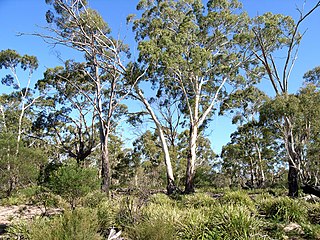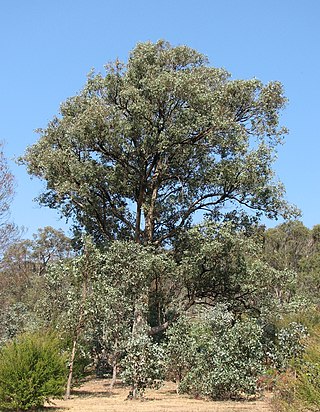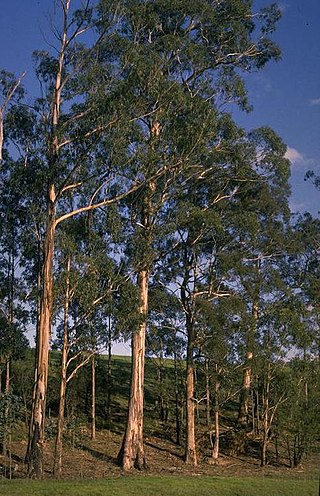
Eucalyptus viminalis, commonly known as the manna gum, white gum or ribbon gum, is a species of small to very tall tree that is endemic to south-eastern Australia. It has smooth bark, sometimes with rough bark near the base, lance-shaped to curved adult leaves, flower buds in groups of three or seven, white flowers and cup-shaped or hemispherical fruit.

Eucalyptus sideroxylon, commonly known as mugga ironbark, or red ironbark is a small to medium-sized tree that is endemic to eastern Australia. It has dark, deeply furrowed ironbark, lance-shaped adult leaves, flower buds in groups of seven, white, red, pink or creamy yellow flowers and cup-shaped to shortened spherical fruit.

Eucalyptus dalrympleana, commonly known as mountain gum, mountain white gum, white gum and broad-leaved ribbon gum, is a species of tree that is endemic to southeastern Australia. It has smooth bark, lance-shaped adult leaves, flower buds in groups of three or seven, white flowers and cup-shaped, bell-shaped or hemispherical fruit.

Eucalyptus macrorhyncha, commonly known as the red stringybark, is a species of medium-sized tree that is endemic to eastern Australia. It has rough, stringy, grey to brown bark, lance-shaped adult leaves, flower buds in groups of between seven and eleven, white flowers and hemispherical fruit.

Eucalyptus radiata, commonly known as the narrow-leaved peppermint or Forth River peppermint, is a species of tree that is endemic to south-eastern Australia. It has rough, fibrous to flaky bark on the trunk and larger branches, smooth grey bark on the thinner branches, lance-shaped to curved or almost linear leaves, flower buds in groups of eleven to twenty or more, white flowers and cup-shaped, hemispherical or shortened spherical fruit.

Eucalyptus goniocalyx, commonly known as long-leaved box, olive-barked box or bundy, is a species of small to medium-sized tree that is endemic to southeastern Australia. It has rough, fibrous or flaky bark, lance-shaped to curved adult leaves, flower buds in groups of seven, white flowers and cup-shaped, cylindrical or barrel-shaped fruit.

Eucalyptus cinerea, commonly known as the Argyle apple, mealy stringbark or silver dollar tree, is a species of small- to medium-sized tree that is endemic to south-eastern Australia. It has rough, fibrous bark on the trunk and branches, usually only juvenile, glaucous, egg-shaped evergreen leaves, flower buds in groups of three, white flowers and conical to bell-shaped fruit.

Eucalyptus tricarpa, commonly known as red ironbark or mugga ironbark, is a species of tree that is endemic to south-eastern Australia. It has thick, rough ironbark on the trunk and branches, lance-shaped adult leaves, flower buds usually in groups of three, white flowers and cylindrical or spherical fruit.

Eucalyptus polyanthemos, commonly known as red box, is a species of small to medium-sized tree, that is native to eastern Australia but has been introduced into other countries. It has fibrous bark on the trunk and larger branches, smooth greyish to cream-coloured bark above, or smooth bark throughout. It has broadly egg-shaped to round juvenile leaves, lance-shaped, egg-shaped or almost round adult leaves, flower buds in groups of seven, white flowers and barrel-shaped to conical fruit.

Eucalyptus tereticornis, commonly known as forest red gum, blue gum or red irongum, is a species of tree that is native to eastern Australia and southern New Guinea. It has smooth bark, lance-shaped to curved adult leaves, flower buds in groups of seven, nine or eleven, white flowers and hemispherical fruit.

Eucalyptus globulus subsp. bicostata, commonly known as the southern blue gum, eurabbie, blue gum or Victorian blue gum, is a subspecies of tree that is endemic to south-eastern Australia. It has mostly smooth bark with some persistent slabs of old bark at the base, juvenile leaves with one glaucous side, glossy, lance-shaped adult leaves, warty flower buds in groups of three, white flowers and hemispherical to conical fruit.

Eucalyptus globulus subsp. maidenii, commonly known as Maiden's gum, is a subspecies of tree that is endemic to southeastern Australia. It has mostly smooth bark with some persistent slabs of old bark at the base, juvenile leaves with one glaucous side, lance-shaped adult leaves, flower buds arranged in groups of seven, white flowers and conical, pedicellate, sometimes glaucous fruit that is more or less square in cross-section

Eucalyptus camphora, commonly known as swamp gum is a flowering plant that is endemic to south-eastern Australia. It is a species of small to medium-sized tree with smooth bark, sometimes rough at the base, broadly lance-shaped to egg-shaped or elliptic adult leaves, flower buds in groups of seven, white flowers and conical fruit. There are two subspecies, subspecies camphora, commonly known as broad-leaved sally or swamp gum and subspecies humeana, commonly known as mountain swamp gum.

Eucalyptus mannifera, commonly known as the brittle gum or red spotted gum, is a species of small to medium-sized tree that is endemic to south-eastern Australia. It has smooth, powdery white bark, lance-shaped to curved adult leaves, flower buds in groups of seven, white flowers and cup-shaped, hemispherical or conical fruit.

Eucalyptus socialis, commonly known as the red mallee, or grey mallee, is a species of mallee that is endemic to inland Australia.

Eucalyptus phenax, commonly known as green dumosa mallee or white mallee, is a species of mallee that is endemic to southern Australia. It has smooth bark, lance-shaped adult leaves, flower buds in groups of seven or nine, white flowers and cup-shaped to cylindrical fruit.
Eucalyptus pauciflora subsp. acerina, commonly known as snow gum, is a mallee or small tree that is endemic to a small area of Victoria, Australia. It has smooth, shiny bark, glossy green lance-shaped to egg-shaped leaves, flower buds in groups of between nine and fifteen, white flowers and hemispherical or conical fruit. It differs from other subspecies of E. pauciflora in having a dense crown and no parts that are glaucous.
Eucalyptus pauciflora subsp. hedraia, commonly known as snow gum, is a mallee or small tree that is endemic to a small area of Victoria, Australia. It has smooth bark, branchlets that are often glaucous, glossy green lance-shaped to egg-shaped or elliptical adult leaves, flower buds in groups of between eleven and fifteen, white flowers and hemispherical or cup-shaped fruit. It differs from other subspecies of E. pauciflora in having larger, sessile, glaucous buds and broader, hemispherical fruit.

Eucalyptus pauciflora subsp. niphophila, commonly known as snow gum, is a small tree or large shrub that is native to a few mountain peaks in eastern Australia. It has smooth bark, glossy green, lance-shaped to egg-shaped or elliptical leaves, flower buds in groups of between nine and fifteen, white flowers and cup-shaped, hemispherical or conical fruit. It differs from other subspecies of E. pauciflora in having more delicate, pedicellate flower buds and smaller leaves.

Eucalyptus pauciflora subsp. pauciflora, commonly known as snow gum, cabbage gum or white sally is a tree or mallee that is endemic to eastern Australia. It has smooth bark, glossy green, lance-shaped, curved or elliptical leaves, flower buds in groups of between nine and fifteen, white flowers and cup-shaped, hemispherical or conical fruit.
























